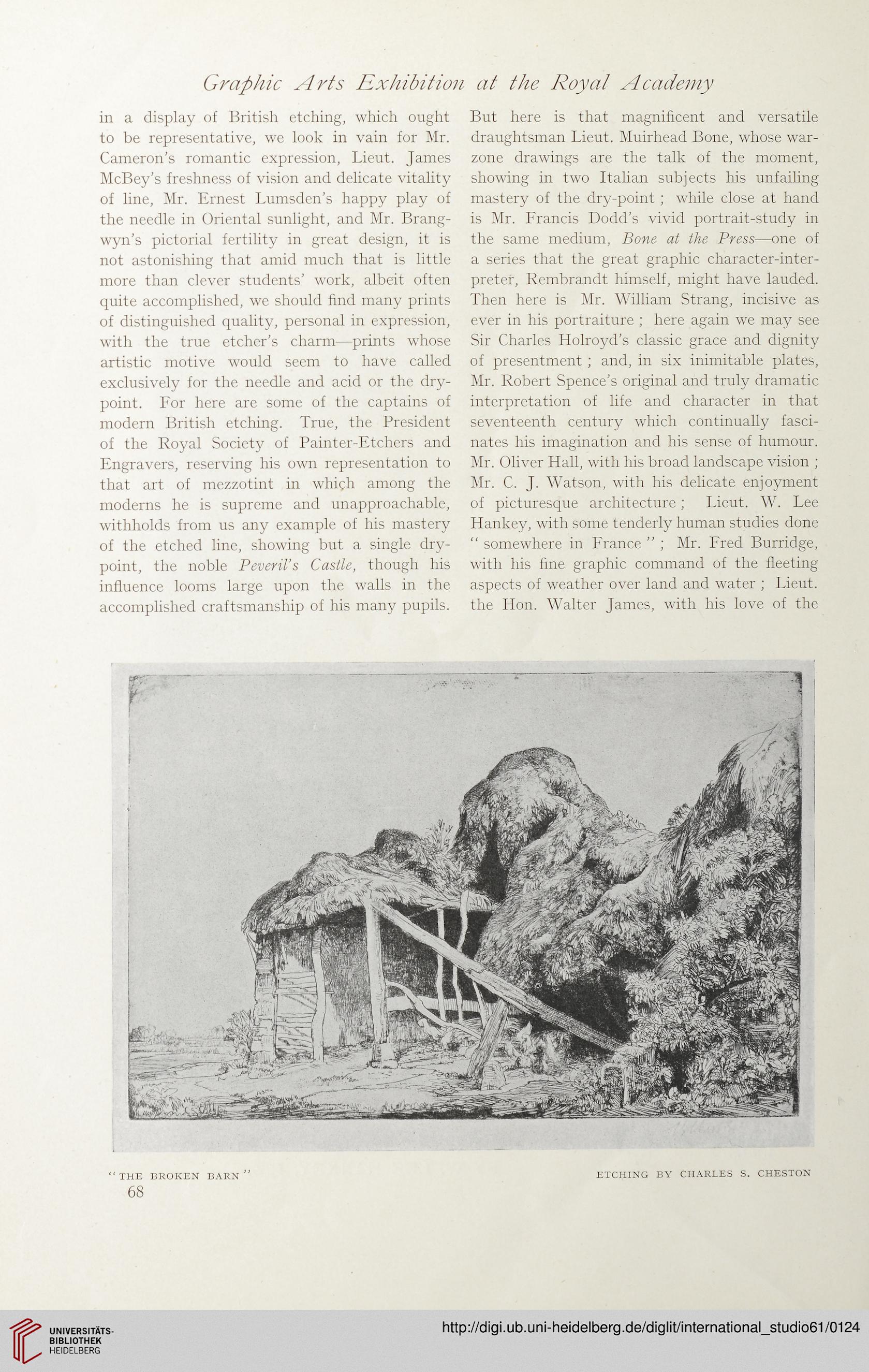Graphic Arts Exhibition at the Roy at Academy
in a display of British etching, which ought
to be representative, we look in vain for Mr.
Cameron’s romantic expression, Lieut. James
McBey’s freshness of vision and delicate vitality
of line, Mr. Ernest Lumsden’s happy play of
the needle in Oriental sunlight, and Mr. Brang-
wyn’s pictorial fertility in great design, it is
not astonishing that amid much that is little
more than clever students’ work, albeit often
quite accomplished, we should find many prints
of distinguished quality, personal in expression,
with the true etcher’s charm—prints whose
artistic motive would seem to have called
exclusively for the needle and acid or the dry-
point. For here are some of the captains of
modern British etching. True, the President
of the Royal Society of Painter-Etchers and
Engravers, reserving his own representation to
that art of mezzotint in which among the
moderns he is supreme and unapproachable,
withholds from us any example of his mastery
of the etched line, showing but a single dry-
point, the noble Peveril’s Castle, though his
influence looms large upon the walls in the
accomplished craftsmanship of his many pupils.
But here is that magnificent and versatile
draughtsman Lieut. Muirhead Bone, whose war-
zone drawings are the talk of the moment,
showing in two Italian subjects his unfailing
mastery of the dry-point; while close at hand
is Mr. Francis Dodd’s vivid portrait-study in
the same medium, Bone at the Press—one of
a series that the great graphic character-inter-
preter, Rembrandt himself, might have lauded.
Then here is Mr. William Strang, incisive as
ever in his portraiture ; here again we may see
Sir Charles Holroyd’s classic grace and dignity
of presentment ; and, in six inimitable plates,
Mr. Robert Spence’s original and truly dramatic
interpretation of life and character in that
seventeenth century which continually fasci-
nates his imagination and his sense of humour.
Mr. Oliver Hall, with his broad landscape vision ;
Mr. C. J. Watson, with his delicate enjoyment
of picturesque architecture; Lieut. W. Lee
Hankey, with some tenderly human studies done
“ somewhere in France ” ; Mr. Fred Burridge,
with his fine graphic command of the fleeting
aspects of weather over land and water ; Lieut,
the Hon. Walter James, with his love of the
“THE BROKEN BARN ” ETCHING BY CHARLES S. CHESTON
68
in a display of British etching, which ought
to be representative, we look in vain for Mr.
Cameron’s romantic expression, Lieut. James
McBey’s freshness of vision and delicate vitality
of line, Mr. Ernest Lumsden’s happy play of
the needle in Oriental sunlight, and Mr. Brang-
wyn’s pictorial fertility in great design, it is
not astonishing that amid much that is little
more than clever students’ work, albeit often
quite accomplished, we should find many prints
of distinguished quality, personal in expression,
with the true etcher’s charm—prints whose
artistic motive would seem to have called
exclusively for the needle and acid or the dry-
point. For here are some of the captains of
modern British etching. True, the President
of the Royal Society of Painter-Etchers and
Engravers, reserving his own representation to
that art of mezzotint in which among the
moderns he is supreme and unapproachable,
withholds from us any example of his mastery
of the etched line, showing but a single dry-
point, the noble Peveril’s Castle, though his
influence looms large upon the walls in the
accomplished craftsmanship of his many pupils.
But here is that magnificent and versatile
draughtsman Lieut. Muirhead Bone, whose war-
zone drawings are the talk of the moment,
showing in two Italian subjects his unfailing
mastery of the dry-point; while close at hand
is Mr. Francis Dodd’s vivid portrait-study in
the same medium, Bone at the Press—one of
a series that the great graphic character-inter-
preter, Rembrandt himself, might have lauded.
Then here is Mr. William Strang, incisive as
ever in his portraiture ; here again we may see
Sir Charles Holroyd’s classic grace and dignity
of presentment ; and, in six inimitable plates,
Mr. Robert Spence’s original and truly dramatic
interpretation of life and character in that
seventeenth century which continually fasci-
nates his imagination and his sense of humour.
Mr. Oliver Hall, with his broad landscape vision ;
Mr. C. J. Watson, with his delicate enjoyment
of picturesque architecture; Lieut. W. Lee
Hankey, with some tenderly human studies done
“ somewhere in France ” ; Mr. Fred Burridge,
with his fine graphic command of the fleeting
aspects of weather over land and water ; Lieut,
the Hon. Walter James, with his love of the
“THE BROKEN BARN ” ETCHING BY CHARLES S. CHESTON
68




